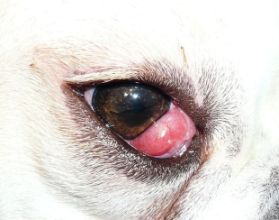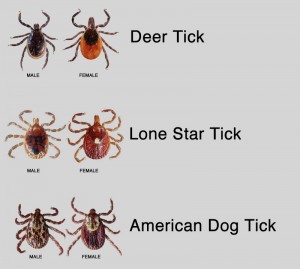February 10, 2016 / by Leann / Make A Comment / Filed under Uncategorized
 The condition commonly called “cherry eye” occurs when a tear gland protrudes from your dog’s eye socket. Easily spotted, it appears as a pink or red mass bulging from the corner of the eye nearest your dog’s nose. It can affect either one or both eyes AND can be recurrent.
The condition commonly called “cherry eye” occurs when a tear gland protrudes from your dog’s eye socket. Easily spotted, it appears as a pink or red mass bulging from the corner of the eye nearest your dog’s nose. It can affect either one or both eyes AND can be recurrent.
Located underneath the nictitating membrane (known as the third eyelid) which protects a dog’s eye from wind, dust and debris, this tear gland provides the cornea with essential lubrication. Once this gland has slipped or prolapsed, your dog’s eye loses most or all of its vital moisture, often resulting in keratocon junctivitis sicca or dry eye, which, if left untreated, can ultimately lead to blindness.
Although “cherry eye” is commonly associated with a congenital weakness of the gland’s attachment in the dog’s eye, it isn’t known if the condition is inherited. And while this condition can affect any breed of dog, it’s more common in Cocker Spaniels, Bulldogs, Beagles, Bloodhounds, Boston Terriers, Lhasa Apsos and Shih Tzu.
As a conscientious dog owner, then, pay attention to: any watery or thick discharge from your dog’s eye; a red or pink blob in the corner of his eye; redness in the lining of one of his eyelids, or persistent pawing at his eye.
If you witness any of the above, allow your vet to examine your dog’s third eyelid to determine precisely what the problem is. The diagnosis can even include scrolled or everted cartilage in the third eyelid, abnormal cells in the third eye, and a prolapse of fat in his eye.
With no preventative measures for “cherry eye” at this time, treatment is the only option. In milder cases, topical anti-inflammatory drugs will usually be prescribed, which are highly effective in reducing the swelling. Keeping your dog’s eyes well lubricated by using the highest quality eye drops may also help prevent a recurrence of the condition.
If corrective surgery is suggested, the tear gland can either be stitched back into place (this procedure is not 100% effective and a prolapse may reoccur) or the third eyelid removed completely, necessitating the use of eye drops every day from then on.
With more research needed into the causes, prevention and treatment of “cherry eye,” all caring dog owners can do is keep a watchful “eye” on their cherished canine companions and keep them safe.
Author: Nomi Berger
November 3, 2015 / by Leann / Make A Comment / Filed under Uncategorized
 Introducing the first annual fundraiser calendar for the 2016 year. Huge thanks to Betsy Sasnett of Betsy Sasnett Photography and Georgianna Hatch of Georgianna Hatch Photography for taking these amazing photos. $9.55 from each 8.5×11″ calendar goes to the CSTR vet fund, so visit the CSTR Online Store and get yours today!
Introducing the first annual fundraiser calendar for the 2016 year. Huge thanks to Betsy Sasnett of Betsy Sasnett Photography and Georgianna Hatch of Georgianna Hatch Photography for taking these amazing photos. $9.55 from each 8.5×11″ calendar goes to the CSTR vet fund, so visit the CSTR Online Store and get yours today!
October 19, 2015 / by Leann / Make A Comment / Filed under Uncategorized
 It’s that time again for goblins and ghosts, pumpkins and pranks, and things that go bump in the night. But as responsible pet owners, please ensure that your dogs and cats aren’t innocent victims of Halloween’s fun and frolics.
It’s that time again for goblins and ghosts, pumpkins and pranks, and things that go bump in the night. But as responsible pet owners, please ensure that your dogs and cats aren’t innocent victims of Halloween’s fun and frolics.
Consider the following suggestions to keep your pets safe not sorry.
- Keep candy out of reach of your pet. Chocolate, especially dark or baking chocolate, can prove toxic for both dogs and cats. Candy containing the artificial sweetener, xylitol, can also cause problems. If you suspect your pet has ingested something toxic, please call your veterinarian or the ASPCA Animal Poison Control Center at (888) 426-4435.
- Although pumpkins and decorative corn are considered relatively non-toxic, they can still produce an upset stomach if nibbled on by your pet.
- Keep wires and cords from lights and other decorations out of reach of your pet. If chewed, your pet might be cut or burned or receive a potentially life-threatening electric shock.
- Although festive, carved pumpkins with candles inside can be easily knocked over by your pet and a fire started. Curious kittens in particular run the risk of being singed or burned by a candle flame.
- Keep costumes for your children and away from your pets unless you’re certain they’re comfortable being decked out, not stressed out, by putting on the “glitz”. Or opt for a Halloween-themed bandanna draped round your pet’s neck.
- Keep all but the most social dogs and cats in a separate room when “trick or treaters” come to call. Even then, take care that your pet doesn’t dart outside when the door first opens.
- Should your pet “pull a Houdini” and vanish, ensure that he/she has either been micro chipped or is wearing a collar and tags for proper identification and a swift return to your anxious arms.
With some strategic planning beforehand, you and your pet can be assured of spending the safest and happiest of Halloweens together.
Author: Nomi Berger
September 4, 2015 / by Leann / Make A Comment / Filed under Uncategorized
 CSTR is holding a Flamingo Flocking fundraiser during the month of September. Send a flock of pink flamingos to roost on a friend, relative, neighbor or other’s yard for 48 hours and help CSTR raise some much-needed funds at the same time. For more information, visit the Flamingo Flocking Fundraiser webpage!
CSTR is holding a Flamingo Flocking fundraiser during the month of September. Send a flock of pink flamingos to roost on a friend, relative, neighbor or other’s yard for 48 hours and help CSTR raise some much-needed funds at the same time. For more information, visit the Flamingo Flocking Fundraiser webpage!
July 21, 2015 / by Leann / Make A Comment / Filed under Uncategorized
 Sadder words were never spoken.
Sadder words were never spoken.
Because an errand meant to take that proverbial minute is 60 seconds too long when a dog is left unattended in a car in the heat.
Why?
Because, even on mild summer days, with a car parked in the shade and the windows cracked, the INSIDE temperature can rapidly reach dangerous levels.
Why?
Because a car acts like a greenhouse, trapping and magnifying the sun’s strength and heat. Both the air and upholstery temperature can rise so rapidly that a dog can’t cool down.
Why?
Because a dog’s normal body temperature is about 102° F. Raise it briefly by only two degrees, and heat exhaustion, brain damage, even death may occur.
Why?
Because dogs don’t sweat. They can only cool themselves by panting and releasing heat through their paws.
Despite repeated warnings in the media, flyers distributed by animal welfare groups, and word of mouth, countless animals still die needlessly each year from heatstroke. Despite the axiom that one person can’t make a difference, in this type of situation, one person can make ALL the difference. And that person may be YOU.
If you see a dog in distress inside a car parked on the street or in a parking lot, note the make and model of the car, as well as its license plate number. Call the police, your local ASPCA branch, Humane Society or animal control immediately.
Watch the dog closely for the more obvious signs of heatstroke: exaggerated panting (or the sudden stopping of panting); an anxious or staring expression; restlessness; excessive salivation, tremors and vomiting. While waiting for help, you may – wherever possible – choose to act on your own.
If a window is opened or a door unlocked, extricate the dog cautiously and carefully — either alone or with assistance. Then, get him into an air-conditioned car or nearby building. Otherwise, lay him down in a cool, shady place. Wet him with cool water, but never apply ice to his body. Fan him vigorously to speed the evaporation process, which, in turn, will cool the blood and reduce his temperature. Give him cool water to drink or even ice cream to lick.
Hopefully, by now, help will have arrived, and you may have saved some neglectful owner’s family pet.
A gentle reminder: don’t YOU become that same neglectful owner.
Remember there’s no such thing as ”just for a minute.“
Author: Nomi Berger
June 21, 2015 / by Leann / Make A Comment / Filed under Uncategorized
The arrival of hot weather and national holidays isn’t always a reason for celebration, especially for noise-phobic dogs. For them, hot weather means thunderstorms, and national holidays, like the Fourth of July, mean fireworks. And that can mean reactions from panting to panic attacks. It may also mean trembling, drooling or whining; pacing or barking; urinating or vomiting.
If you own this type of dog, it means bearing helpless witness to your pet’s extreme fear. Fortunately, there are various ways to deal with your animal’s distress. The first is to defuse the situation before it begins. Play a recording of the sounds of thunder at a low volume for brief intervals, adjusting the volume according to your dog’s responses, repeating this procedure over and over again.
But if a thunderstorm or fireworks display has already started, there are several coping strategies you can try:
* Divert your dog’s attention. Turn on the radio or television, engage in some active games and be generous with the treats.
* Provide your dog with a dark, comfortable place to hide – from a dog crate or the inside of a closet to a folded blanket under the bed. Being tucked away in a small, snug space allows your dog to feel more secure and muffles the noise outside.
* Buy dog-appeasing pheromones (their scent is similar to those released by nursing mother dogs), available in sprays, diffusers and collars.
* Bind a form fitting, fabric wrap or thick, woven shirt tightly around your dog. Both garments are meant to touch certain pressure points in your dog’s body, slowing down the heart, reducing knots of tension and helping to promote relaxation.
* If, however, your pet’s anxieties escalate, there are two remaining alternatives. Working with a qualified dog therapist to learn behavior modification techniques, or talking to your vet to see if a prescription for anti-anxiety medication may help.
But, whichever path you choose, follow it with kindness, patience and love. Think back to the sounds that frightened you as a child, and you’ll know just how your precious pet is feeling.
Author: Nomi Berger
June 17, 2015 / by Leann / Make A Comment / Filed under Uncategorized
Picture yourself on a sweltering summer day wearing a long winter coat.
Are you hot yet? Itchy? Thirsty? Looking for shade?
Now picture your dogs on that same summer day. And you’ll have some idea of how THEY feel.
Protecting them from the hot sun, air and ground is essential to keeping them safe outside. All it requires is common sense and some advance planning.
Here are some suggestions:
For dogs with particularly thick or heavy coats, have a groomer lightly trim them back.
Guard against sunburn by applying either a child’s SPF 45 sun block or a specially formulated animal sunscreen to the tips of your dog’s ears, the nose and the belly.
Whether on a porch, patio or lawn, create a shaded area using planters or shrubbery.
Set up a makeshift canopy using a blanket draped across two chairs.
Limit your dog’s outdoor exercise. Take your walks early in the morning or when the sun is setting. If the day’s particularly hot and humid, forego your walks altogether.
Turn on a garden sprinkler and let your dog run through it or fill a small wading pool with water
Keep your dog’s water bowl filled, cool, and free of floating debris.
Avoid hot asphalt, which can quickly burn the pads of your dog’s paws. Place the back of your hand to the sidewalk or pavement. If you can’t keep it there for seven seconds, then it’s too hot for your dog. If possible, walk your dog on the grass instead.
Never leave your dog unattended in the car. Whether in the shade with the windows cracked or with the motor running and the air conditioning on, your car can become a deathtrap within minutes.
Watch your dog for signs of heat exhaustion. Because dogs don’t sweat, their only way of cooling down is by panting or releasing heat through their paws. Warning signs include exaggerated panting, excessive salivation, a vacant expression, restlessness or listlessness, trembling and skin that’s hot to the touch.
If your dog is exhibiting any of these signs, get him into the shade as quickly as possible. Give him cool water to drink and either hose him down, cover him with cool, damp cloths or put him in a bathtub filled with cool water. If your dog’s condition worsens, seek immediate medical attention.
To be a responsible pet owner is to be an informed pet owner.
The list of safety rules may seem long, but the hot days of summer are even longer.
Author: Nomi Berger
May 20, 2015 / by Leann / Make A Comment / Filed under Uncategorized
 With the arrival of summer comes the arrival of an annoying and possibly fatal pest: the tick.
With the arrival of summer comes the arrival of an annoying and possibly fatal pest: the tick.
What was once considered a nuisance found only in the wooded countryside has been persistently and increasingly invading cities both large and small. Now ticks can be as close as your neighborhood park or your neighbor’s backyard.
What, precisely, is a tick? A tick is a fairly common, external parasite that embeds itself in the skin of both animals and humans. Once it lands, it inserts its mouthparts into the skin and feeds on the blood. And that single tick has the potential to pass on multiple diseases.
Deer ticks and Western Blacklegged ticks can carry Lyme disease and Rocky Mountain spotted fever, which animals (and humans) can contract.
Prevention and early detection are the best ways of protecting your pets against Lyme disease. The intent is to stop it before any symptoms appear. Should the disease progress, symptoms can include stiff, painful and swollen joints, and a limp that comes and goes, often appearing to switch sides. Some dogs have an arched back and a stiff walk. More serious, however, are fever, difficulty breathing and kidney failure. Heart and neurological problems are rarer.
To help protect your pet, there are several preventatives available – such as K9 Advantix – which stops ticks BEFORE they bite, killing, not only all of the major tick species, but acting as a flea treatment as well. A product meant only for dogs, K9 Advantix must NOT be applied on or to dogs in a home with cats.
Such preventatives are particularly important for high-risk animals such as hunting dogs, cottage dogs, and dogs hiking through fields. But it’s important to remember that dogs (and cats) can pick up ticks in the city as well.
When bitten, the skin of some pets may become red and irritated around the site, while others may not even notice the parasite attached to them. It is imperative then, that you inspect your pet thoroughly when returning from areas known for ticks.
Should you find a tick on your pet, it must be removed very carefully to ensure that the mouthparts are fully removed. If left behind, they can abscess and cause infection. Kill the tick by placing it in a zip-lock bag and pouring rubbing alcohol over it. For the uncertain owner, special tick removal devices are available, while the squeamish can have their vet remove the tick instead.
Some experts now advise that when your pet is tested annually for heartworm, the same test include screening for Lyme disease, ehrlichiosis and anaplasmosis (both bacterial infections). A positive test result enables you to start treating your pet early — before the onset of any symptoms.
Never was the expression “an ounce of prevention is worth a pound of cure” more true.
Author: Nomi Berger
May 13, 2015 / by Leann / Make A Comment / Filed under Uncategorized
T he major culprits: trees, grasses, pollens, molds and ragweed. The main cause: inhaling these irritants through the nose and mouth.
he major culprits: trees, grasses, pollens, molds and ragweed. The main cause: inhaling these irritants through the nose and mouth.
Unlike humans, most dogs’ allergies manifest themselves as skin irritations or inflammations known as allergic dermatitis. Left untreated, your dog’s constant scratching can lead to open sores and scabs, hair loss and hot spots. Ear infections, running noses, watery eyes, coughing and sneezing may also occur.
To determine the source of your dog’s allergy, ask your vet to conduct a series of tests: intradermal, blood or both.
Once a specific allergen has been identified, you can try the following:
Avoidance: for pollens, keep your dog away from fields; keep lawns short; keep her indoors when pollen counts are high; vacuum and wash floors with non-toxic agents instead of regular household cleaners containing chemicals.
Topical therapies: frequent baths with an oatmeal-free shampoo; foot soaks to reduce tracking allergens into the house; topical solutions containing hydrocortisone to ease the itching.
Diet: one low in carbohydrates like grain, or low in fat; put omega-3 fatty acids and/or coconut oil in her food; add a combination of the naturopathic supplements quercetin, bromelain and papain to her meals.
Drugs: antihistamines, cyclosporine or steroids.
As always, consult your vet before starting any form of treatment. Monitor your dog’s behaviour closely and report any improvement or worsening in her condition.
It may take several attempts before the proper treatment is found. But when it is, your dog will be much more comfortable — and so will you.
Author: Nomi Berger
April 21, 2015 / by Leann / Make A Comment / Filed under Uncategorized
 A single bite from a single infected mosquito can cause an otherwise healthy dog to develop heartworm disease and potentially die.
A single bite from a single infected mosquito can cause an otherwise healthy dog to develop heartworm disease and potentially die.
A heartworm is a parasitic worm (Dirofilaria immitis) that lives in the heart and pulmonary arteries of an affected dog. The worms travel through the bloodstream, damaging arteries and vital organs as they go, before arriving at the lungs and heart approximately six months after that initial mosquito bite. Several hundred worms can live in a single dog from between five and seven years, and if left untreated, can prove fatal.
The best protection against this insidious disease? Prevention. Prevention is both safe and effective, whereas treating the disease itself is complicated, costly, and can, like the disease, have serious, even fatal, effects on the stricken dog.
Preventives work by killing the heartworm larvae before they can grow and mature into adult heartworms. Although a variety of preventives are now available to conscientious pet owners everywhere, the first step in the prevention process is a visit to the vet.
Most vets recommend yearly testing for heartworm in dogs older than 6 months, usually in late spring. If your dog is heartworm negative, inexpensive, chewable pills are available with your vet’s prescription. The pills, which are palatable to most dogs, must be given to your dog monthly and are manufactured by several companies. These pills can also be given to dogs under 6 months of age without a blood test.
Besides pills, there are specially designed, chemical preventive products that you apply directly onto your dog’s skin. Some heartworm preventives contain additional ingredients that will control other parasites, such as roundworms or hookworms, while the topical preventives prescribed by your vet will protect your dog against fleas and ticks as well.
If you choose the vet-prescribed pill, you can opt to give it to your dog only during mosquito season (from spring through the first frost), but the most recent recommendation from the American Heartworm Society is to keep giving them all year round. And remember, although your dog may not go outside, mosquitoes can still get INside.
For those preferring to NOT use either the pill or the topical preventive, homeopathic veterinarians advise testing your dog for heartworm twice yearly.
In short, consult with your vet. Protect the dog you love against these invasive, potentially fatal parasites, and this summer all of you can rest, assured.
Author: Nomi Berger
 The condition commonly called “cherry eye” occurs when a tear gland protrudes from your dog’s eye socket. Easily spotted, it appears as a pink or red mass bulging from the corner of the eye nearest your dog’s nose. It can affect either one or both eyes AND can be recurrent.
The condition commonly called “cherry eye” occurs when a tear gland protrudes from your dog’s eye socket. Easily spotted, it appears as a pink or red mass bulging from the corner of the eye nearest your dog’s nose. It can affect either one or both eyes AND can be recurrent.








